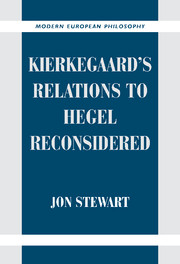Book contents
- Frontmatter
- Contents
- Acknowledgements
- Abbreviations of Primary Texts
- Preface
- Introduction
- 1 Kierkegaard and Danish Hegelianism
- 2 Traces of Hegel in From the Papers of One Still Living and the Early Works
- 3 The Ironic Thesis and Hegel's Presence in The Concept of Irony
- 4 Hegel's Aufhebung and Kierkegaard's Either/Or
- 5 Kierkegaard's Polemic with Martensen in Johannes Climacus, or De omnibus dubitandum est
- 6 Kierkegaard's Repetition and Hegel's Dialectical Mediation
- 7 Hegel's View of Moral Conscience and Kierkegaard's Interpretation of Abraham
- 8 Martensen's Doctrine of Immanence and Kierkegaard's Transcendence in the Philosophical Fragments
- 9 The Dispute with Adler in The Concept of Anxiety
- 10 The Polemic with Heiberg in Prefaces
- 11 Subjective and Objective Thinking: Hegel in the Concluding Unscientific Postscript
- 12 Adler's Confusions and the Results of Hegel's Philosophy
- 13 Kierkegaard's Phenomenology of Despair in The Sickness unto Death
- 14 Kierkegaard and the Development of Nineteenth-Century Continental Philosophy: Conclusions, Reflections, and Reevaluations
- Foreign Language Summaries
- Bibliographies
- Subject Index
- Index of Persons
11 - Subjective and Objective Thinking: Hegel in the Concluding Unscientific Postscript
Published online by Cambridge University Press: 13 March 2010
- Frontmatter
- Contents
- Acknowledgements
- Abbreviations of Primary Texts
- Preface
- Introduction
- 1 Kierkegaard and Danish Hegelianism
- 2 Traces of Hegel in From the Papers of One Still Living and the Early Works
- 3 The Ironic Thesis and Hegel's Presence in The Concept of Irony
- 4 Hegel's Aufhebung and Kierkegaard's Either/Or
- 5 Kierkegaard's Polemic with Martensen in Johannes Climacus, or De omnibus dubitandum est
- 6 Kierkegaard's Repetition and Hegel's Dialectical Mediation
- 7 Hegel's View of Moral Conscience and Kierkegaard's Interpretation of Abraham
- 8 Martensen's Doctrine of Immanence and Kierkegaard's Transcendence in the Philosophical Fragments
- 9 The Dispute with Adler in The Concept of Anxiety
- 10 The Polemic with Heiberg in Prefaces
- 11 Subjective and Objective Thinking: Hegel in the Concluding Unscientific Postscript
- 12 Adler's Confusions and the Results of Hegel's Philosophy
- 13 Kierkegaard's Phenomenology of Despair in The Sickness unto Death
- 14 Kierkegaard and the Development of Nineteenth-Century Continental Philosophy: Conclusions, Reflections, and Reevaluations
- Foreign Language Summaries
- Bibliographies
- Subject Index
- Index of Persons
Summary
Kierkegaard published the Concluding Unscientific Postscript on February 28, 1846, and many individual bits of evidence indicate that it is a crucial text in his literary corpus as a whole. It was of course the companion volume to the Philosophical Fragments and was therefore published under the same pseudonym, Johannes Climacus. Moreover, the Postscript represents one of the most comprehensive statements of his mature views: not only do earlier ideas find their full expression there, but outlines of a number of views developed later can also be discerned. The Postscript is one of the most philosophical texts authored by Kierkegaard and has been regarded by some commentators as the origin of the existential tradition of European philosophy. All of this has made it one of his most read works and one of the most important for the reception of his thought in general.
In reviewing his authorship as a whole, Kierkegaard himself reserves a special place for the Postscript, designating it “the turning point” in his literary work. In his own account of his literary career in The Point of View for My Work as an Author, he explains his general publication plan and the unique role of the Postscript therein. There he omits his early book-review, From the Papers of One Still Living, and his dissertation, The Concept of Irony, and declares that his authorship began in 1843 with Either/Or.
- Type
- Chapter
- Information
- Kierkegaard's Relations to Hegel Reconsidered , pp. 448 - 523Publisher: Cambridge University PressPrint publication year: 2003

